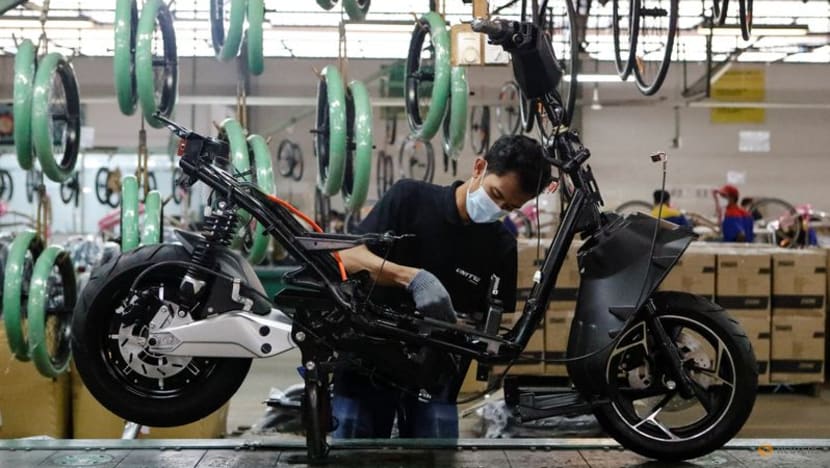Indonesia expands subsidy for electric motorcycles to more people; riders and experts say further measures needed

An employee works at the assembly line of an electric motorcycle at the United E-Motor factory in Bogor, near Jakarta in Indonesia on Aug 25, 2022. (File photo: Reuters/Ajeng Dinar Ulfiana)
SINGAPORE: More Indonesians are now able to buy electric motorcycles at a subsidised cost under an expanded assistance programme by the government, though some road users and experts point out that this alone may not be enough to persuade consumers to make the switch.
According to state news agency Antara, Minister of Industry Agus Gumiwang Kartasasmita said on Tuesday (Aug 29) that the public will receive a discount of 7 million rupiah (US$460), which is valid for a one-time purchase of an electric motorcycle.
"For people who want to (utilise) this government assistance programme, the conditions are that (they are) Indonesian citizens aged at least 17 years old and have an electronic ID card.
“One resident ID number can buy one unit of electric motorcycle," Mr Kartasasmita reportedly said in a statement.
The expansion of the assistance programme comes five months after the government first introduced the subsidy to selected groups of people earlier in March. Back then, those who are beneficiaries of the people’s business credit programme, among others, were eligible for the subsidy.
The main basis for the policy change is to accelerate the building of an electric vehicle (EV) ecosystem in the country and create a cleaner Indonesia, Mr Kartasasmita said.
"This goal, of course, will have an impact on increasing investment, spurring industrial productivity and competitiveness, as well as expanding the workforce,” he was quoted as saying by Antara.
Indonesians whom CNA spoke to remain uninterested in purchasing the electric two-wheeler, with many citing the high costs as well as unfamiliarity with brands in the market as a deterrent despite the subsidy expansion.
Mr Agung Purwadi, who lives in Bekasi, said that purchasing an electric motorcycle is out of his budget. He added that the battery pack used to power electric motorcycles may lose capacity over time and that they cannot be charged everywhere.
“The motor is also not rigid and unstable. Resale is difficult and the resale price is (also lower). After-sales (service) is also not guaranteed such as the availability of spare parts,” Mr Purwadi told CNA.
The high cost is also deterring another Indonesian resident from switching over from the conventional fuel-based motorcycle to the environmentally-friendly alternative.
Mr Suryadi, who like many Indonesians goes by one name, said: “I’m not interested in buying it as the price is still too high. Also, the brand is not familiar (to me), I've only just heard of it.
“Where can I find spare parts if something breaks? It's different if it's a well-known brand like Honda, Yamaha or Suzuki. With the economy as it is now, it doesn't make sense at that price,” added the resident from Subang, West Java.
Checks by CNA showed that electric motorcycle brands in Indonesia include local brands such as Viar, Selis, Gesits and Alva as well as China’s Wuling, among others. Prices for these electric motorcycles range from 4.8 million rupiah to 37.75 million rupiah.
Meanwhile, Mr Eka Indra, who lives in Bogor noted that the electric motorcycle may not be able to support his weight, in addition to that of a passenger’s.
He added that the quietness of the vehicle may also pose a safety risk.
“I will not buy an electric motorcycle even though my wife wants it. Judging from the physicality of the EV, I don't think I will be able to ride it. I weigh 116kg, not to mention my wife. I doubt that the bike would be able to carry me, especially on climbs.
“Another concern is that this electric motorcycle has no sound because as a person who has been riding a motorcycle for a long time, in addition to the rearview mirror, we also have to hear the sound of the motorcycle to maintain the driving safety,” he said.
Mr Isa, who resides in Depok, expressed his wariness on whether an electric motorcycle is truly an environmentally-friendly alternative.
“I think as long as the electricity is still generated by electric steam power plants (which) still uses coal, it may not even have a significant impact. Not to mention the problem of EV battery waste that cannot be recycled.
“The policy should be to improve and cheapen public transport so that people can change their behaviour from taking private vehicles to public transport,” he said.
Related:
According to the Jakarta Post, Mr Putra Adhiguna - an energy analyst at the Institute of Energy Economics and Financial Analysis (IEEFA) - said that electric motorcycle sales had risen 191 per cent from around 12,000 units in 2021 to 35,000 last year.
Responding to a query from CNA, Mr Adhiguna said that in order to further the sale of electric motorcycles, there needs to be a stronger push on automakers as the major market holders ultimately shape consumer demand.
“A big complication for Indonesia is that nearly the entire two-wheeler market is held by two or three brands, all of which are not really moving fast in adopting electrics,” Mr Adhiguna told CNA.
He added that the government needs more sophisticated plans in pushing the technology envelope, such as staging incentives to promote EV with longer travel distance, battery charging convenience and safety performance.
“It is wise to start with regional targets, as the adoption of (electric motorcycles) may be more feasible in particular geographies, such as urban users, rather than rural users which need to travel very long distances,” he said.
Another analyst whom CNA spoke to said that the new assistance program is in line with the government’s goal of reaching 48,000 to 50,000 electric motorcycles by year-end and 200,000 by 2024.
“Before, you had to be an MSME (Micro and Small Medium Enterprise) or had a subsidised KUR (People’s Productive) loan from the government. Now you just need to be over 17 years old and have a KTP (National Identity Card).
“So the projected increase hasn’t happened. This new regulation is hoped to address this,” said Mr Manggi Taruna Habir, a Visiting Fellow at ISEAS – Yusof Ishak Institute, who does research on the EV industry in Indonesia.
In order to increase the adoption of electric motorcycles, government and industry players could help to facilitate a secondary market for electric motorcycles, he added.
“(They could also) help to standardise motorcycle batteries so that the swapping of motorcycle batteries in small motorcycle garages can further develop and grow,” said Mr Habir.
Dr Raymond Ong Ghim Ping, an associate professor in the Department of Civil and Environmental Engineering at the National University of Singapore (NUS), told CNA that Indonesia does indeed have a potential for the EV market.
“The main issue is that they need to actually have a network of charging stations … or even (battery swapping points) for the electric motorcycle market to come up,” said Dr Ong.
He added that for some of the working people in the middle-income group and below, a form of subsidy is “enough to tilt the needle towards the adoption of electric motorcycles”.
Meanwhile, Dr Harun Al Rasyid, a professor from the Bandung Institute of Technology's (ITB) Faculty of Civil and Environmental Engineering said that the government will eventually detail more information on how to gain more market confidence or sales of EVs.
“In my opinion, certainly mouth-to-mouth marketing amongst EV users (on the advantages of EV) is more effective,” he told CNA.
He added that the government should “play their two cards” by introducing incentives - or carrots - for EVs, and at the same time impose a restriction - or sticks - to the use of internal combustion engine (ICE) vehicles.
“A longer planning horizon will be needed after the general election, after 2024,” said Dr Al Rasyid.
Additional reporting by Denny Armandhanu.


















